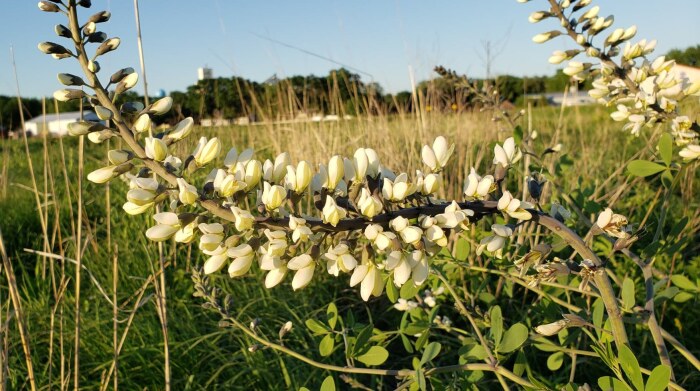Katie Byerly shares another spectacular series of wildflower photos from northeast Iowa. Katie is also known as Iowa Prairie Girl on YouTube.
What is your favorite wildflower? I enjoy so many that it’s a hard question to answer. I do know that whenever I see White wild indigo (Baptisia alba macrophylla), I can’t help but smile.
Let me share a few reasons why this is one of my favorite wildflowers.
White wild indigo is easy to spot. I love the way it shoots up over other prairie flowers and grasses. In this image you can see how it stands out above other early summer forbs. The plant typically grows to be 2 to 5 feet tall.

Here is another image of the Indigo towering over other plants in a restored county planting in Cerro Gordo County, IA.

I like to grown sedums and succulents at home. Both the waxy stem and calyx of the white wild indigo remind me of my favorite houseplants. I love how the tubular bluish green calyx hold the pearly white petals.


Quoting Illinois Wildflowers: “The white flowers occur in erect spike-like racemes up to 2′ long and are quite showy. They are typical pea flowers and about 1″ long.”

I don’t think I can fully describe the white of a white whild indigo flower petal. Perhaps it depends on the day and the lighting. Opalescent would be a good word. I enjoy the bright clean white petals in the shiny sunny mid-summer day but also gold pearl color at sunset. It really brings me pleasure to see the different ways this plant catches the sun.


I captured these images at dusk.


It wasn’t till I was researching indigo for my YouTube video that I realized that white wild indigo has an orange stamen. In order to see the stamen, one needs to pinch the pea shaped flower open for a peek inside.

It would really be great it white wild indigo had my favorite wildflower leaf type—clasping—or even better, perfoliated. But I can’t have everything. Indigo leaves are compound in groups of three. They too are a fun greyish or blue green.

The Indigo plant grows into a bush-like structure, Once learned the plant is easy to identify by the leaves even before the flowers appear.

After the bloom, the seed pods begin to develop from the flower. In this image, you can see the green color as the pods begin to form.

Here is an image of the spike full of plump seed pods. (That’s Prairie Dog near the bottom of the frame.)

The pods eventually turn black.

Another name for this species is rattlepod, because of the noise made when you shake a pod with seeds inside.

Like the seed pods, the whole plant also turns black as it dries up in the fall. On a windy day the dried plant will roll away like a tumbleweed, spreading its seeds as it tumbles. Just another reason to like white wild indigo.
Editor’s note: Here is Katie Byerly’s YouTube video about white wild indigo.


1 Comment
White wild indigo is a wonderful plant...
…and it’s great to see it featured here. Thank you, Katie Byerly and BH.
Seeing these photos did remind me that I heard about one Iowa public prairie planting, adjacent to a prairie remnant, where white wild indigo plants appeared even though wild white indigo had not been planted. Wild white indigo was not found anywhere in the remnant or the surrounding area, and the planting had only included seed from the remnant itself. The conclusion reached by conservation staff was that some anonymous person had decided to add some indigo seed to the planting.
This is not the first time I’ve heard of new plant species being added anonymously to Iowa public land. There are certainly some situations where adding new plant species to public restorations and natural areas is appropriate, or even needed. But for a variety of reasons, adding new species should not be done on a stealth basis.
PrairieFan Thu 13 Oct 11:04 PM